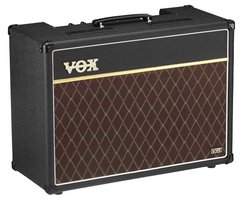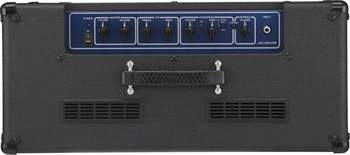A few years ago, Vox launched their legendary AC30 as an amp head or as a combo, all made in China at an affordable price. This year, VOX is spoiling us with a hybrid series, using a special amplification technology mixing transistors and tube. This 15 Watts model is what’s on the menu for today.
Hybrid Technology
 Everyone has heard of Marshall’s hybrid series (Valvestate) or Fender’s. It was often a mix between a transistor amplifier and a 12AX7 tube as a preamplifier. This technique allowed them to smooth out a little transistor stiffness and also to allow these amps to properly take on the pedals’ full power. (reminds me of my Marshall 8080 First series).
Everyone has heard of Marshall’s hybrid series (Valvestate) or Fender’s. It was often a mix between a transistor amplifier and a 12AX7 tube as a preamplifier. This technique allowed them to smooth out a little transistor stiffness and also to allow these amps to properly take on the pedals’ full power. (reminds me of my Marshall 8080 First series).
VOX uses here a different technology in the VR series: The preamp section is provided by transistors and the op-amp, while the amplifying part is based on a single 12AX7! What ?! This can’t be right! I admit, I myself second guessed this specification, but it is correct and verified. It is the same technology that was used in the Valvetronix series. This “amplification” tube has even been renamed “Valve Reactor” for the occasion.
Explanation: A 12AX7 tube is a dual triode, which is present in the circuitry only to give color to the sound. It is then connected to a solid state power amplifier where the transistor amplifier is more powerful and neutral than the tube amplifier. The tube therefore serves to color the signal, the bulk of the amplification being provided by the transistors.
Autopsy
The amp features separate channels: a clear controlled by the “normal volume” and a channel focused more crunch / distortion with two gain levels (OD1 and OD2). The “master” section includes the overall volume of the amp. It is best to adjust the volume of the channel used to get the desired sound (gain level) and then raise the master meter to increase the general level, being careful not to push too hard, otherwise saturation is inevitable (but if you want to, go ahead!). In this same section, there is also a digital reverb that quickly becomes rough when you push a little volume. But it is enough to give a little life to clean sound if you do not exceed 9 o’clock on the dial. You can manually engage it the by raising the potentiometer or by using the optional foot switch. The latter also allows you to switch between channels.
The VOX AC 15VR is equipped with a two band equalizer bass / treble, like almost all VOX amps if I remember correctly. Pushing the bass potentiometer, it overwrites the signal to unravel the inherent charm of VOX amps. Try the setting Palm Mute pushed, and you’ll understand. As for the treble, the sound tends to become a little aggressive after 12 o’clock both on its clean and distortion channels.
 We notice a control panel that runs essentially unadorned or without any funky colors. But don’t laugh at VOX, in this model there is no amp simulation, no useless effects, no loops effects, no direct output. You just plug and play!
We notice a control panel that runs essentially unadorned or without any funky colors. But don’t laugh at VOX, in this model there is no amp simulation, no useless effects, no loops effects, no direct output. You just plug and play!
On the rear panel, it is possible to connect an external speaker to the amplifier and to bypass the internal speaker. Be careful to respect the 8 Ohms impedance and perform the operation when the amplifier is off!
Let’s Get to Work
VOX AC15VR is a 15 Watt amp equipted with a Celestion Custom 12 inches. Thanks to its master volume, it is possible to push the amp to get a distortion of the tube. We get a good crunch, or pushing the gain further, a fairly modern distortion. We easily find a nice sound, that is simply and effortlessly shaped, just need to understand the different volume principles.
The amp does not vibrate at high volume, there is no residual noise, and its appearance and finish are good points in its favor. I noticed a heating time of a few seconds before using the amp, it proves the presence of at least one tube.
Two guitars were plugged in the beast: a Gibson Les Paul Custom and a 1978 Fender Stratocaster 1972. The samples were recorded at Studio UFO with a Shure SM57 and a BeyerDynamic M160 plugged into a Chandler Limited TG2 without EQ or compression, all in an Interface Digidesign 192 I / O.
I was careful to take pictures of the settings used at the EQ level. The amp lacks a little bass, and thus Vox offers, a pretty saturation when you push the Bass volume potentiometer.

Listening to the samples, we realize that it sounds OK for the crunch and the clean soft tones, but the overdrive type 2 is a bit “pushy”, one could say it is more “modern” but too dirty to be used properly.
When pushing the bass (like in the picture settings), the sound is nicely compressed. Treble quickly become aggressive when you push it a little, I noticed this phenomenon on the Stratocaster and Telecaster Thinline guitar models.
On the amp level, The amplifier is sufficient for playing in an apartment. You only need a drummer, a bassist, and a lumberjack to drown out the poor AC15VR (it’s normal you might say). There is a 30-watt version (AC30VR) for those who would like to use it in rehearsals or in a band setting. Otherwise, if you can connect a 4×12 to the external output of the AC15VR, it will be very difficult to get clear sounds at a high levels.
Another detail that is important: the channel switching is not without mishap. The sound crashed half a second before reaching the overdrive channel, which is not too classy before launching into a guitar solo or going into a big rhythmic improv. I have experienced amps going “poc” when changing channels, but here it is more of a short fade out.
Conclusion
 To conclude, this little amp found for less than $400 in the USA, is sufficient for guitarists who want to play at home with the master volume that can push the gain without making enemies in the neighborhood. It has no Speaker output, but output to an external cabinet is possible. We appreciate the ease of use, the little time it takes to find good quality sound. In short, unless you hate the sound philosophy and VOX itself you can buy it with your eyes closed.
To conclude, this little amp found for less than $400 in the USA, is sufficient for guitarists who want to play at home with the master volume that can push the gain without making enemies in the neighborhood. It has no Speaker output, but output to an external cabinet is possible. We appreciate the ease of use, the little time it takes to find good quality sound. In short, unless you hate the sound philosophy and VOX itself you can buy it with your eyes closed.
- Good value for the money
- Construction Quality
- Nice crunch
- Output to connect another Speaker
- A little heavy for a 15 Watt
- The overdrive type 2 too dirty
- Channel switching not very smooth


